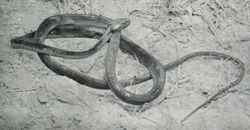Biology:Toxicodryas blandingii
| Toxicodryas blandingii | |
|---|---|

| |
| Scientific classification | |
| Domain: | Eukaryota |
| Kingdom: | Animalia |
| Phylum: | Chordata |
| Class: | Reptilia |
| Order: | Squamata |
| Suborder: | Serpentes |
| Family: | Colubridae |
| Genus: | Toxicodryas |
| Species: | T. blandingii
|
| Binomial name | |
| Toxicodryas blandingii (Hallowell, 1844)
| |
| Synonyms[2] | |
| |
Toxicodryas blandingii, commonly known as Blanding's cat snake, Blanding's tree snake, and Blandings [sic] tree snake, is a species of rear-fanged venomous snake of the family Colubridae. The species is endemic to Sub-Saharan Africa.
Etymology
The specific name, blandingii, is in honor of William Blanding (1772–1857), an American physician and naturalist.[3]
Geographic range
T. blandingii is found in Angola, Benin, Cameroon, Central African Republic, Congo, DR Congo, Equatorial Guinea, Gabon, Gambia, Ghana, Guinea, Guinea-Bissau, Ivory Coast, Kenya, Liberia, Nigeria, Senegal, Sierra Leone, Sudan, Togo, Uganda, and Zambia.[2]
Habitat
The preferred natural habitats of T. blandingii are forest and savanna, at altitudes from sea level to 2,200 m (7,200 ft). However, it is also found in gardens, parks, and in and around houses.[1]
Description
T. blandingii is a long and slender species. The longest specimen measured by Boulenger (1896) had a total length of 2.2 m (7.2 ft), including a tail 0.5 m (1.6 ft) long.
Diet
T. blandingii preys upon lizards including dwarf chameleons, small mammals including bats, and birds.[1]
Reproduction
T. blandingii is oviparous.[2] Clutch size is 7–14 eggs.[1]
References
- ↑ 1.0 1.1 1.2 1.3 Rödel M-O, Luiselli L, Segniagbeto G, Howell K, Msuya CA, Ngalason W (2021). "Toxicodryas blandingii ". The IUCN Red List of Threatened Species 2021: https://dx.doi.org/10.2305/IUCN.UK.2021-2.RLTS.T13265740A13265749.en. Accessed on 14 March 2023.
- ↑ 2.0 2.1 2.2 Species Toxicodryas blandingii at The Reptile Database
- ↑ Beolens, Bo; Watkins, Michael; Grayson, Michael (2011). The Eponym Dictionary of Reptiles. Baltimore: Johns Hopkins University Press. xiii + 296 pp. ISBN:978-1-4214-0135-5. (Boiga blandingii, p. 27).
Further reading
- Boulenger GA (1896). Catalogue of the Snakes in the British Museum (Natural History). Volume III., Containing the Colubridæ (Opisthoglyphæ and Proteroglyphæ) .... London: Trustees of the British Museum (Natural History). (Taylor and Francis, printers). xiv + 727 pp. + Plates I-XXV. (Dipsadomorphus blandingii, pp. 77–78).
- Hallowell E (1844). "Descriptions of New Species of African Reptiles". Proceedings of the Academy of Natural Sciences of Philadelphia 2: 169–172. (Dipsas blandingii, new species, pp. 170–171).
- Nagy ZT, Kusamba C, Tungaluna GG, Lokasola AL, Kolby J, Kielgast J (2011). "Foraging acrobatics of Toxicodryas blandingii in the Democratic Republic of the Congo". Herpetology Notes 4: 91–92.
- Pauwels OSG, Vogel G (2011). "Ein Fall von Thanatose (Totstellreflex) bei Boiga blandingii (Squamata, Serpentes, Colubridae) in Gabun [= A case of thanatosis (play-dead reflex) in Boiga blandingii (Squamata, Serpentes, Colubridae) in Gabon]". Elaphe 19 (4): 24–25. (in German).
- Spawls S, Howell K, Hinkel H, Menegon M (2018). Field Guide to East African Reptiles, Second Edition. London: Bloomsbury Natural History. 624 pp. ISBN:978-1472935618. (Toxicodryas blandingii, p. 511).
Wikidata ☰ Q3535999 entry


